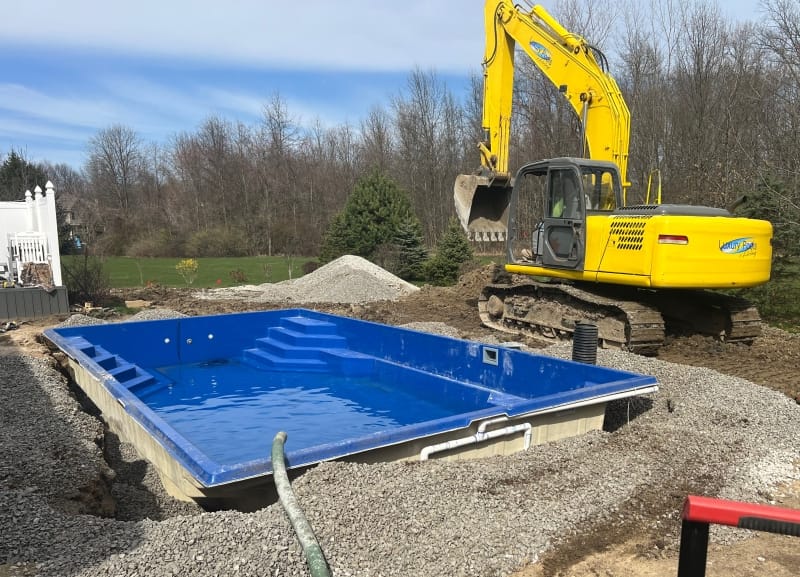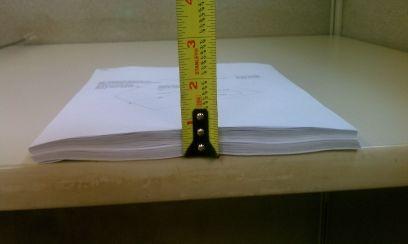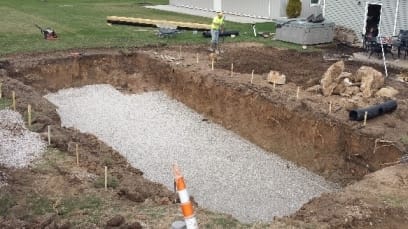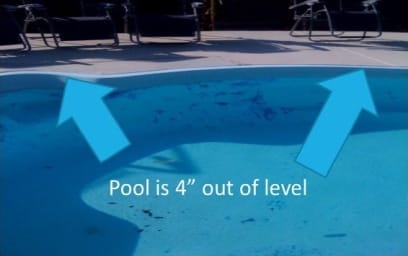So you think installing a fiberglass pool is easy? So did I. Part 1/3

So you want to install your own fiberglass pool. OK. For most people the prospect of installing their own swimming pool means savings. The process of installing a fiberglass pool is not that difficult. Most mechanical people after a glance over some installation pictures have a basic handle on it. Dig, set, backfill, form and pour the concrete. Let's face it $10,000-$15,000 in potential savings can get about anyone's attention.
When I first got into the business, I did so almost by accident and thought it was going to be easy. I owned a construction company, had all the tools, equipment, trucks, and even staff to do it. I remember thinking how easy this was going to be. What turned out to be simple was a battle. What wasn't so obvious were the so-called tricks of the trade and the "what not to do's" learned only through experience. It took three 16-hour days to install my first pool CORRECTLY, and I earned every bit of it. With close to 1000 pool installed, we have a saying: It's not hard to do... But it is easy to screw up.
Permits

 The first hurdle you will need to overcome is the permit process. In most areas there is some type of code. The problem is that each local municipality (many rural areas don't even have a department) observes their own local code and sometimes only some of the state code. Building departments also must work with whatever zoning code is enforced in the area if a separate zoning department exists. Unfortunately, it is up to you to wade through the homeowners' association, zoning department, then the building department (in that order) to make sure they are all OK with what you want to do and making sure you know EXACTLY what inspection each will want and WHEN. At the least most departments will require you to follow National Electric Code (NEC). Overlooking an inspection could be your biggest mistake. Be diligent. You don't want to dig something back out.
The first hurdle you will need to overcome is the permit process. In most areas there is some type of code. The problem is that each local municipality (many rural areas don't even have a department) observes their own local code and sometimes only some of the state code. Building departments also must work with whatever zoning code is enforced in the area if a separate zoning department exists. Unfortunately, it is up to you to wade through the homeowners' association, zoning department, then the building department (in that order) to make sure they are all OK with what you want to do and making sure you know EXACTLY what inspection each will want and WHEN. At the least most departments will require you to follow National Electric Code (NEC). Overlooking an inspection could be your biggest mistake. Be diligent. You don't want to dig something back out.
Layout
Establishing the elevation of an inground pool is the next thing you can seriously mess up. Before you know where to install the base (or foundation) you need to know what kind of deck you're going to be installing, how it's going to be installed, and what the thicknesses are. Then you must know how the fall (or slopes) on the apron will work. There's nothing more upsetting than water not draining away from the pool or worse, rain draining back into the pool or foundation of the house. I've seen inground pools where the rainwater collected in flower beds and flooded dirt and mulch all over the pool deck every time it rained. There's no easy one plan fits all when it's time to lay out your project. It just has to be right or you're going to be digging something out.
Excavation

 Once we know how the space is going to be laid out and have determined the elevation of the fiberglass pool shell, it's time to dig the hole. The physical act of digging the hole is easy. But there are few things we do and don't want to do. First and foremost, DON'T over dig. Bigger may sometimes be better but not here. My first hole was over dug by 20" I had plenty of space to work and getting the backfill back in was easy, but it also cost me an extra $1,400 in stone and $500 in dirt hauling. This doesn't even factor in the time it took to dig that extra dirt or the labor to put all that extra fill back in. An ideal over dig is about 8" at grade which will translate into 20" at the base of the swimming pool. Next make sure you know exactly what the shape of the pool is and where your stairs and bench seats are. DO leave the dirt for contours and steps. If you dig a square hole and don't leave the dirt where the features of the swimming pool are, it's easy to toss another $1,200 in stone away. Don't add dirt back into the hole to make up for excessive over dig. If you disturb it, it must come out and stay out. Disturbed dirt will not compact and will eventually settle. Lastly DON'T dig your hole any deeper than you have to. A thicker base doesn't make it better. Three to five inches of the right material is perfect. If you dig extra deep and have an 8" or 12" stone base it will be much harder to adequately compact that much material which means you will have to deal with settling of the fiberglass pool (what I call hyper compaction). A thicker base also costs a lot more money in stone and is lot more work.
Once we know how the space is going to be laid out and have determined the elevation of the fiberglass pool shell, it's time to dig the hole. The physical act of digging the hole is easy. But there are few things we do and don't want to do. First and foremost, DON'T over dig. Bigger may sometimes be better but not here. My first hole was over dug by 20" I had plenty of space to work and getting the backfill back in was easy, but it also cost me an extra $1,400 in stone and $500 in dirt hauling. This doesn't even factor in the time it took to dig that extra dirt or the labor to put all that extra fill back in. An ideal over dig is about 8" at grade which will translate into 20" at the base of the swimming pool. Next make sure you know exactly what the shape of the pool is and where your stairs and bench seats are. DO leave the dirt for contours and steps. If you dig a square hole and don't leave the dirt where the features of the swimming pool are, it's easy to toss another $1,200 in stone away. Don't add dirt back into the hole to make up for excessive over dig. If you disturb it, it must come out and stay out. Disturbed dirt will not compact and will eventually settle. Lastly DON'T dig your hole any deeper than you have to. A thicker base doesn't make it better. Three to five inches of the right material is perfect. If you dig extra deep and have an 8" or 12" stone base it will be much harder to adequately compact that much material which means you will have to deal with settling of the fiberglass pool (what I call hyper compaction). A thicker base also costs a lot more money in stone and is lot more work.

 Now that the hole's dug you need to determine what type of soil you have. Sandy soil or peat will settle a lot while clay settles about half. This has to be considered when installing your base. Isolation may be needed if you are putting stone on sandy soil or boggy soil. If there is going to be settling (and there usually is to some degree plus settling from thick base as mentioned above) you must raise your base at the heavy points to account for the settle and hyper compaction. Unfortunately, this is not a science but very much an art. Each fiberglass pool model and size will react differently in different soil. This is just something you have to feel out and be able to compensate for what hasn't happened yet. My first pool I set perfectly level and the next day it had settled 3/4". Now I know most installers talk about being level to 1.5" but that's pretty sad and not acceptable in my opinion. Incredibly some installers accept level to 4"-6" with the intention of hiding it with a cantilever concrete deck and or a tiled waterline. As amazing as that sounds, I fix a couple of these every year. This is the result of laziness and inexperience. With proper planning and diligence even the cheapest thinnest fiberglass pool can be set level to 1". Our sets at level to 1/4" in most all situations.
Now that the hole's dug you need to determine what type of soil you have. Sandy soil or peat will settle a lot while clay settles about half. This has to be considered when installing your base. Isolation may be needed if you are putting stone on sandy soil or boggy soil. If there is going to be settling (and there usually is to some degree plus settling from thick base as mentioned above) you must raise your base at the heavy points to account for the settle and hyper compaction. Unfortunately, this is not a science but very much an art. Each fiberglass pool model and size will react differently in different soil. This is just something you have to feel out and be able to compensate for what hasn't happened yet. My first pool I set perfectly level and the next day it had settled 3/4". Now I know most installers talk about being level to 1.5" but that's pretty sad and not acceptable in my opinion. Incredibly some installers accept level to 4"-6" with the intention of hiding it with a cantilever concrete deck and or a tiled waterline. As amazing as that sounds, I fix a couple of these every year. This is the result of laziness and inexperience. With proper planning and diligence even the cheapest thinnest fiberglass pool can be set level to 1". Our sets at level to 1/4" in most all situations.
Pool Article Categories:
Copyright Luxury Pools and Living 2005-2024
Cookie Policy | Privacy Policy